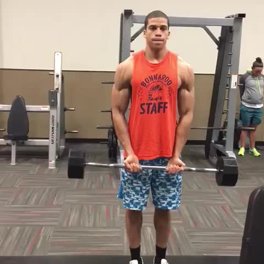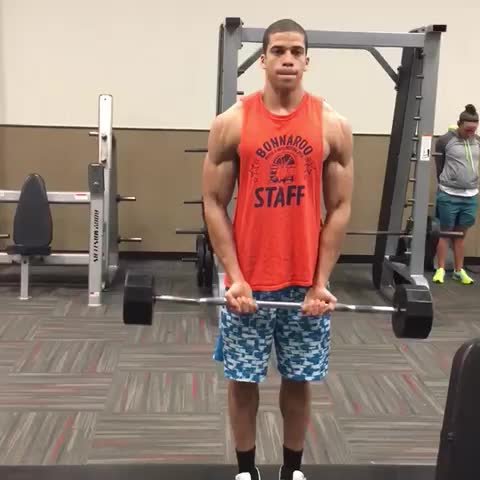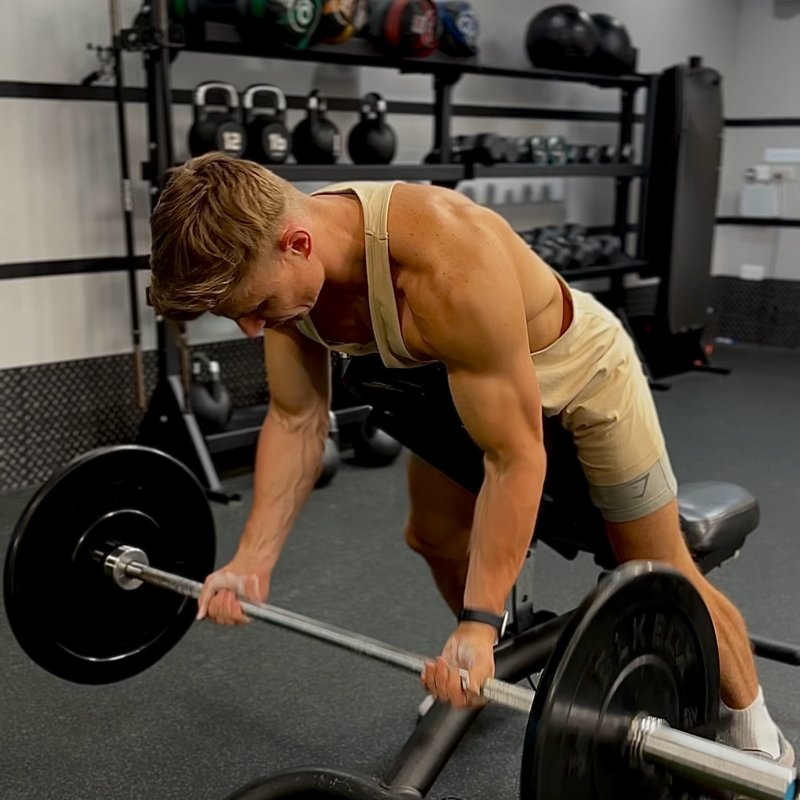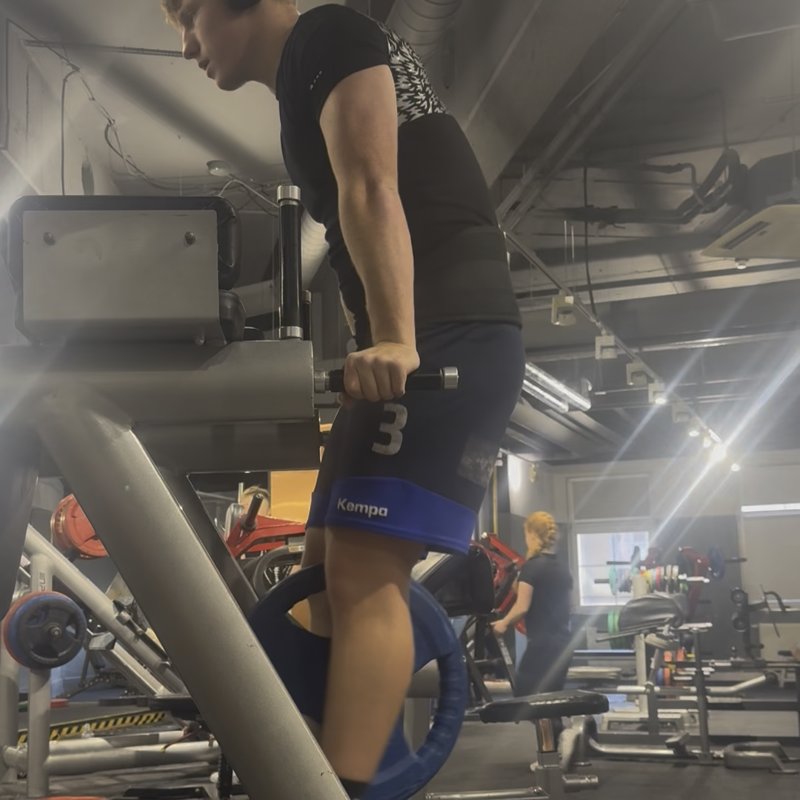EZ Bar Curl: The Ultimate Guide
The EZ Bar Curl is a biceps isolation exercise performed with an undulating barbell that places the wrists in a semi-supinated position, targeting the biceps brachii while reducing strain on the wrists and elbows compared to straight barbell curls.

Quick Facts
Key Benefit
Comprehensive biceps development with enhanced joint comfort
Primary Muscles
Biceps, Brachialis
Secondary Muscles
Abdominals, Anterior Deltoids, Forearms, Traps
Equipment
barbell
Difficulty
Beginner
Type
Strength
In This Guide
Ready to master the EZ Bar Curl?
Track your progress, see improvements over time, and build strength consistently.
Download GravitusThe EZ Bar Curl stands as one of the most popular and effective exercises for developing the biceps brachii, the prominent two-headed muscle on the front of the upper arm. This timeless movement offers a perfect balance between the strict isolation of dumbbell curls and the heavy loading potential of straight barbell curls.
What makes the EZ bar particularly valuable is its ergonomic design—the undulating shape places your hands in a semi-supinated position (between fully supinated and neutral), creating more natural alignment for the wrists and elbows compared to a straight barbell. This modified grip position reduces the joint stress that some lifters experience with traditional barbell curls while still allowing for substantial resistance and bilateral symmetry.
As a compound isolation exercise, the EZ Bar Curl primarily targets the biceps brachii, but also engages the brachialis (the muscle beneath the biceps) and brachioradialis (the upper forearm muscle), creating comprehensive development across the entire anterior arm. The fixed bilateral nature of the movement also prevents strength imbalances that can sometimes develop with unilateral exercises.
Whether you're looking to build impressive arm size, increase functional pulling strength, or simply develop a more balanced physique, the EZ Bar Curl deserves consideration as a cornerstone exercise in your training program. Its versatility, effectiveness, and joint-friendly design make it appropriate for nearly all training populations when performed with proper technique.
Benefits of EZ Bar Curls
The EZ Bar Curl offers several unique advantages that make it a valuable addition to any arm training program.
Joint-Friendly Design
The semi-supinated grip position creates more natural wrist and elbow alignment compared to straight barbell curls, potentially reducing joint stress.
Stable Loading Pattern
The fixed bilateral nature of the movement promotes balanced muscle development while allowing for heavier loading than many unilateral variations.
Full Biceps Recruitment
Effectively targets both heads of the biceps brachii while also engaging the brachialis and brachioradialis for comprehensive arm development.
Progressive Overload Potential
The barbell design facilitates precise weight increments, making it easy to implement systematic progressive overload over time.
Practical Convenience
Requires minimal equipment and setup, allowing for efficient training in both commercial gyms and home workout environments.
Proper Form & Technique
Setup
- Stand with feet approximately shoulder-width apart for a stable base.
- Grasp the EZ bar with an underhand grip, hands positioned at the inner curve of the bar.
- Position your hands slightly wider than shoulder-width apart, or at a width that feels comfortable for your individual structure.
- Let the bar hang at arm's length against your thighs, with elbows fully extended but not locked.
- Keep your shoulders pulled back and down, chest up, and maintain a neutral spine position.
- Place your elbows close to your sides where they will remain fixed throughout the movement.
- Distribute your weight evenly across both feet, with a slight bend in the knees for stability.
- Engage your core to maintain proper posture and prevent unwanted back movement.
Movement
- Keeping your upper arms stationary against your sides, flex at the elbow to curl the bar upward.
- Focus on contracting your biceps to move the weight rather than using momentum or body English.
- Continue curling until your forearms are approximately vertical and the bar is at shoulder level.
- At the top position, focus on squeezing your biceps for a momentary isometric contraction.
- Slowly lower the bar back to the starting position with control, fully extending the arms without locking the elbows.
- Maintain tension in the biceps throughout the entire range of motion, not allowing the weight to hang passively at the bottom.
- Keep your elbows fixed in position throughout the movement, not allowing them to drift forward or away from your sides.
- Exhale during the concentric (lifting) phase and inhale during the eccentric (lowering) phase.
Key Form Tips
Elbow Position
Keep your elbows close to your sides throughout the entire movement, as if they were glued to your ribcage.
Controlled Movement
Avoid using momentum or swinging the torso to lift the weight, instead focus on isolated biceps contraction.
Full Range of Motion
Lower the weight completely at the bottom position without losing tension, and curl to full contraction at the top.
Wrist Position
Maintain a neutral wrist position throughout the movement, avoiding excessive flexion or extension that can create strain.
Posture Maintenance
Keep your torso upright throughout the exercise, resisting the tendency to lean backward as the weight ascends.
Muscles Worked
Primary Muscles
- biceps: The two-headed muscle on the front of the upper arm, primarily responsible for elbow flexion and forearm supination, which is the main target of this exercise.
- brachialis: The muscle located beneath the biceps that assists with elbow flexion regardless of forearm rotation, receiving significant stimulation during the exercise.
Secondary Muscles
- brachioradialis: The forearm muscle that assists with elbow flexion, particularly involved due to the semi-supinated grip position of the EZ bar.
- anterior deltoids: The front shoulder muscle that provides minor assistance during the curling motion, particularly if strict form isn't maintained.
- forearms: The muscles of the inner forearm that activate during gripping and assist with wrist stabilization throughout the movement.
- abdominals: Engage isometrically to maintain proper posture and prevent swinging during the exercise.
- traps: The upper back muscles that work isometrically to keep the shoulders stable throughout the movement.
Common Mistakes and How to Fix Them
Using Momentum
Swinging the torso or using body "English" to lift the weight rather than isolated biceps contraction. Focus on keeping your upper body stationary throughout the movement. If necessary, reduce the weight until you can perform the exercise with strict form. Consider performing the exercise with your back against a wall to eliminate the potential for swinging. Implement a deliberate tempo, such as 2 seconds up, 1 second squeeze, and 3 seconds down, to enforce controlled movement.
Moving the Elbows
Allowing the elbows to drift forward or away from the sides during the movement, which reduces biceps isolation and can increase shoulder involvement. Consciously keep your elbows pinned to your sides throughout the entire range of motion. Imagine squeezing a newspaper between your upper arms and ribcage to maintain proper position. If elbow movement persists, consider temporarily reducing the weight until proper form becomes habitual. Perform the exercise near a mirror to provide visual feedback on elbow position.
Incomplete Range of Motion
Not fully extending the arms at the bottom or not curling to a complete contraction at the top, limiting muscle development. Focus on achieving a full range of motion with each repetition, from complete arm extension (without locking elbows) to full biceps contraction. Ensure you're not using too heavy a weight that prevents proper range of motion. Consider implementing "21s" technique occasionally (7 reps bottom half, 7 reps top half, 7 full reps) to develop strength through the complete range.
Wrist Flexion/Extension
Excessively bending the wrists during the movement, which can reduce force transfer to the biceps and potentially cause wrist strain. Maintain a neutral wrist position throughout the exercise, thinking of your hands as hooks that simply hold the weight. Ensure you're using an appropriate weight that doesn't force wrist deviation. Consider using wrist wraps temporarily if wrist position control is particularly challenging. Focus on feeling the tension in the biceps rather than the forearms.
Excessive Forward Lean
Leaning the torso backward to assist with lifting the weight, particularly as fatigue sets in, which can place stress on the lower back. Maintain an upright posture with a neutral spine throughout the exercise. If necessary, perform the exercise with your back against a wall. Engage your core muscles before initiating each repetition to support proper positioning. Reduce the weight if maintaining proper posture becomes difficult, especially during later repetitions.
EZ Bar Curl Variations
Grip Variations
-
Wide Grip EZ Bar Curl
Placing the hands on the outer curves of the EZ bar, which can place greater emphasis on the inner head of the biceps.
-

Narrow Grip EZ Bar Curl
Positioning hands closer together on the innermost curves, potentially increasing emphasis on the outer head of the biceps.
-
Reverse Grip EZ Bar Curl
Using an overhand grip (pronated) to shift emphasis toward the brachialis and brachioradialis while reducing biceps brachii involvement.
-

Offset Grip EZ Bar Curl
Intentionally gripping the bar asymmetrically to create an imbalanced load that increases stabilization demands.
Technical Variations
-

Preacher EZ Bar Curl
Performing the curl with the upper arms supported on a preacher bench, which eliminates momentum and emphasizes the lower portion of the biceps.
-

Incline EZ Bar Curl
Executing the curl while lying back on an incline bench, which increases the stretch on the biceps and can enhance long head development.
-
EZ Bar Drag Curl
Keeping the elbows fixed and dragging the bar up the torso during the curl, maximizing biceps contraction while minimizing anterior deltoid involvement.
-
EZ Bar 21s
A high-intensity method that divides the range of motion into three 7-rep segments (lower half, upper half, and full range) within a single extended set.
Frequently Asked Questions
Neither implement is universally "better" - both have distinct advantages, and the ideal choice depends on individual factors including joint comfort, training goals, and personal preference.
The EZ bar offers several benefits: The semi-supinated grip position typically creates more comfortable wrist and elbow alignment for most lifters. The angled grips reduce stress on the wrist joints while still allowing substantial loading. Many find the EZ bar allows them to maintain stricter form due to the more natural hand position.
The straight barbell maintains its own advantages: The fully supinated grip maximizes biceps brachii activation, potentially leading to greater overall biceps stimulation. The straight design may allow slightly heavier loading due to more direct force transfer. The standard grip position can more effectively target the supination function of the biceps.
For most lifters, especially those with any history of wrist or elbow discomfort, the EZ bar represents an excellent default choice that balances effective stimulation with joint comfort. However, there's no reason to use exclusively one or the other - many successful training programs incorporate both implements, either across different training sessions or different phases of a program.
The most important factor isn't which bar you choose, but rather how effectively you execute the movement - maintaining strict form, appropriate loading, and consistent progression over time. Listen to your body's feedback and select the implement that allows you to train most effectively and comfortably.
The appropriate weight for EZ bar curls depends on your training experience, current strength level, and most importantly, your ability to maintain proper form throughout the exercise.
As a general guideline, select a weight that allows you to complete your target repetitions with strict form while still finding the last 2-3 reps challenging. For most beginners, this often means starting with just the EZ bar itself (typically 15-25 pounds depending on manufacturer) or with very light added weight. Intermediate lifters might work with 40-70 pounds total weight, while advanced lifters might use 70-100+ pounds for their working sets. However, these numbers vary significantly based on individual factors and should never be considered universal standards.
The key indicators that your weight selection is appropriate include: You can maintain fixed elbow position throughout the movement. You can perform the exercise without using momentum or body swing. You achieve a full range of motion with each repetition. You feel primary fatigue in your biceps rather than forearms or shoulders. You can maintain proper wrist and spine positioning throughout the set.
For biceps development, many find that moderate weights with perfect execution produce better results than heavier weights with compromised form. Consider implementing systematic progression by first increasing repetitions with a given weight (e.g., working from 8 to 12 reps), then adding weight and starting again at the lower rep range. Small weight increases (2.5-5 pounds) work well for sustainable progression with biceps exercises.
Remember that biceps are relatively small muscles compared to larger muscle groups like legs or back, so the absolute weight used will be comparatively modest even for advanced lifters. Focus on the quality of muscle contraction rather than the quantity of weight moved.
The optimal grip width on EZ bar curls balances effective biceps stimulation with comfortable joint positioning for your individual structure. While there's no universal "perfect" width that applies to everyone, several principles can guide your decision.
For most lifters, a grip that positions hands slightly wider than shoulder-width apart, using the innermost curves of the EZ bar, provides a good starting point. This moderate width typically creates balanced stimulation across the biceps while maintaining comfortable wrist and elbow positioning.
Different grip widths can subtly alter muscle emphasis: A wider grip (hands on the outer curves) may place slightly more emphasis on the inner (short) head of the biceps. A narrower grip may increase emphasis on the outer (long) head of the biceps. However, these differences are relatively subtle compared to other factors like overall execution quality.
Individual factors that should influence your grip width include: Your shoulder width and bone structure. Any history of elbow, wrist, or shoulder discomfort. The specific EZ bar you're using, as designs vary between manufacturers. Your personal comfort and the position that allows you to feel maximum biceps engagement.
Rather than adhering to a rigid recommendation, experiment with slightly different grip widths to discover what feels most effective for your individual biomechanics. The optimal position will allow you to maintain fixed elbows, comfortable wrist alignment, and maximum biceps engagement throughout the movement.
For comprehensive development, consider occasionally varying your grip width across different workouts or training phases to ensure complete stimulation of the biceps from multiple angles.
Ensuring biceps emphasis during EZ bar curls requires attention to several key technique elements that minimize shoulder involvement. When executed properly, the exercise should create significant tension in the biceps with minimal anterior deltoid activation.
The most important technique factor is maintaining fixed elbow position throughout the movement. Keep your elbows pinned to your sides from start to finish, as if they were glued to your ribcage. The moment your elbows drift forward, the anterior deltoids become increasingly involved. Try performing the exercise with your back against a wall to help maintain proper position.
Several other technique adjustments can help maximize biceps emphasis: Focus on curling with the biceps rather than "lifting" the weight, emphasizing the mind-muscle connection. Maintain an upright torso position throughout the movement, avoiding the tendency to lean backward as the weight ascends. Use a controlled tempo, particularly during the lowering phase, rather than relying on momentum. Keep your wrists in a neutral or slightly extended position, not flexed forward. Consider curling to approximately chin height rather than all the way to the shoulders, which can help maintain stricter form.
If shoulder involvement remains problematic, consider these modifications: Temporarily reduce the weight until proper form becomes habitual. Try preacher curls or concentration curls, which mechanically limit shoulder involvement. Implement a focused pre-exhaustion technique, performing isolation curls before your EZ bar curls to pre-fatigue the biceps. Experiment with seated EZ bar curls, which can make it easier to maintain proper positioning for some individuals.
Remember that some minimal shoulder stabilization is normal and unavoidable, but the primary movement should come from elbow flexion driven by the biceps, not from shoulder flexion.
Video Demonstrations

Log in to watch video demonstrations
Login to Watch3 video demonstrations available
Tips from the Community
-

Reverse grip
-

Drop set with reverse grip
Track your progress with Gravitus
Download Gravitus to log your workouts, track your progress, and join a community of fitness enthusiasts.

Helpful Resources
One Rep Max Calculator
Find your one rep max for any exercise without maximal testing. Essential for developing effective strength training programs.
Calculate 1RMWorkout Programs
Follow structured workout programs created by fitness professionals to maximize your strength and muscle gains.
View Programs




